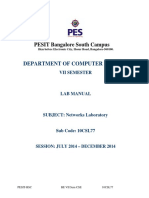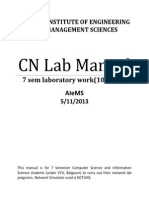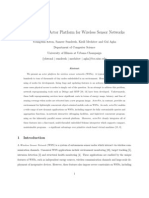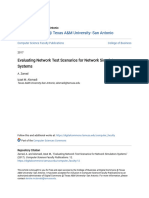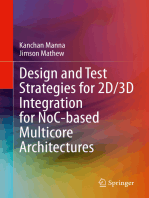Network Simulation
Network Simulation
Uploaded by
saikrishnakodaliCopyright:
Available Formats
Network Simulation
Network Simulation
Uploaded by
saikrishnakodaliOriginal Description:
Copyright
Available Formats
Share this document
Did you find this document useful?
Is this content inappropriate?
Copyright:
Available Formats
Network Simulation
Network Simulation
Uploaded by
saikrishnakodaliCopyright:
Available Formats
Network simulation
In communication and computer network research, network simulation is a technique where a program models the behavior of a network either by calculating the interaction between the different network entities (hosts/packets, etc.) using mathematical formulas, or actually capturing and playing back observations from a production network. The behavior of the network and the various applications and services it supports can then be observed in a test lab; various attributes of the environment can also be modified in a controlled manner to assess how the network would behave under different conditions. When a simulation program is used in conjunction with live applications and services in order to observe end-to-end performance to the user desktop, this technique is also referred to as network emulation.
Network simulator
A network simulator is software or hardware that predicts the behavior of a computer network without an actual network being present. In simulators, the computer network is typically modeled with devices, traffic etc. and the performance is analysed. Typically, users can then customize the simulator to fulfill their specific analysis needs. Simulators typically come with support for the most popular protocols and networks in use today, such as WLAN, Wi-Max, TCP, WSN, cognitive radio etc
Simulations
Most of the commercial simulators are GUI driven, while some network simulators are CLI driven. The network model / configuration describes the state of the network (nodes,routers, switches, links) and the events (data transmissions, packet error etc.). An important output of simulations are the trace files. Trace files log every packet, every event that occurred in the simulation and are used for analysis. Network simulators can also provide other tools to facilitate visual analysis of trends and potential trouble spots. Most network simulators use discrete event simulation, in which a list of pending "events" is stored, and those events are processed in order, with some events triggering future eventssuch as the event of the arrival of a packet at one node triggering the event of the arrival of that packet at a downstream node. Some network simulation problems, notably those relying on queueing theory, are well suited to Markov chain simulations, in which no list of future events is maintained and the simulation consists of transiting between different system "states" in a memoryless fashion. Markov chain simulation is typically faster but less accurate and flexible than detailed discrete event simulation. Simulation of networks is a very complex task. For example, if congestion is high, then estimation of the average occupancy is challenging because of high variance. To estimate the likelihood of a buffer overflow in a network, the time required for an accurate answer can be extremely large. Specialized techniques such as "control variates" and "importance sampling" have been developed to speed simulation.[1][2]
Examples of network simulators
There are many both open-source and commercial network simulators.Examples of notable network simulation software are, ordered after how often they are mentioned in research papers: 1. ns2/ns3 2. OPNET 3. NetSim
Uses of network simulators
Network simulators serve a variety of needs. Compared to the cost and time involved in setting up an entire test bed containing multiple networked computers, routers and data links, network simulators are relatively fast and inexpensive. They allow engineers, researchers to test scenarios that might be particularly difficult or expensive to emulate using real hardware - for instance, simulating a scenario with several nodes or experimenting with a new protocol in the network. Network simulators are particularly useful in allowing researchers to test new networking protocols or changes to existing protocols in a controlled and reproducible environment. A typical network simulator encompasses a wide range of networking technologies and can help the users to build complex networks from basic building blocks such as a variety of nodes and links. With the help of simulators, one can design hierarchical networks using various types of nodes like computers,hubs, bridges, routers, switches, links, mobile units etc. Various types of Wide Area Network (WAN) technologies like TCP, ATM, IP etc. and Local Area Network (LAN) technologies like Ethernet, token rings etc., can all be simulated with a typical simulator and the user can test, analyze various standard results apart from devising some novel protocol or strategy for routing etc. Network simulators are also widely used to simulate battlefield networks in Network-centric warfare There are a wide variety of network simulators, ranging from the very simple to the very complex. Minimally, a network simulator must enable a user to represent a network topology, specifying the nodes on the network, the links between those nodes and the traffic between the nodes. More complicated systems may allow the user to specify everything about the protocols used to handle traffic in a network. Graphical applications allow users to easily visualize the workings of their simulated environment. Textbased applications may provide a less intuitive interface, but may permit more advanced forms of customization.
You might also like
- Software-Defined Networks: A Systems ApproachFrom EverandSoftware-Defined Networks: A Systems ApproachRating: 5 out of 5 stars5/5 (1)
- Network SimulatorDocument3 pagesNetwork SimulatorRachana SayanakarNo ratings yet
- Network SimuDocument3 pagesNetwork SimuvalicuinfoNo ratings yet
- Exp4 MainDocument3 pagesExp4 Mainhimanshu kumarNo ratings yet
- Ex No: 6 Raw Sockets (Packet Capturing & Filtering)Document6 pagesEx No: 6 Raw Sockets (Packet Capturing & Filtering)Pitchairaj BhuvaneswariNo ratings yet
- The Role of Nctuns For Communication EngineeringDocument9 pagesThe Role of Nctuns For Communication Engineeringu_upalNo ratings yet
- Key Features and Optimum Performance of Network Simulators: A Brief StudyDocument7 pagesKey Features and Optimum Performance of Network Simulators: A Brief StudyseventhsensegroupNo ratings yet
- A Survey of Network Simulation Tools: Current Status and Future DevelopmentsDocument6 pagesA Survey of Network Simulation Tools: Current Status and Future DevelopmentsSebastián Ignacio Lorca DelgadoNo ratings yet
- EX - NO: 7 Study of Network Simulator (NS) and Simulation of Congestion Control Algorithms Using NS AIMDocument9 pagesEX - NO: 7 Study of Network Simulator (NS) and Simulation of Congestion Control Algorithms Using NS AIMnitheschitrav07No ratings yet
- A Survey of Network Simulation Tools - Current Status and Future DevelopmentDocument13 pagesA Survey of Network Simulation Tools - Current Status and Future DevelopmentuflillaNo ratings yet
- Experiment - 1: Aim: A Brief Introduction To Network Simulation Through The Netsim Simulation PackageDocument3 pagesExperiment - 1: Aim: A Brief Introduction To Network Simulation Through The Netsim Simulation PackageYash GuptaNo ratings yet
- Qualnet SimulatorDocument12 pagesQualnet SimulatorGeorge Rahul PaulNo ratings yet
- 10.3922 Devendra - CompressedDocument6 pages10.3922 Devendra - CompressedDr-Pawan Singh KoriNo ratings yet
- Network Simulation Using OPNETDocument16 pagesNetwork Simulation Using OPNETTema HassanNo ratings yet
- Digital CommunicationDocument43 pagesDigital CommunicationRavi kumarNo ratings yet
- Wireless Mesh Network Simulation Framework For Omnet++: Create-Net Technical Report Cn-Tr-200700016Document23 pagesWireless Mesh Network Simulation Framework For Omnet++: Create-Net Technical Report Cn-Tr-200700016Darlison OsorioNo ratings yet
- CN Exp 11Document4 pagesCN Exp 11MAYURI PAWARNo ratings yet
- Date: Study of Network Simulator ToolsDocument11 pagesDate: Study of Network Simulator ToolsAshutosh GuptaNo ratings yet
- A Survey of Network Simulators Supporting Wireless Networks PDFDocument11 pagesA Survey of Network Simulators Supporting Wireless Networks PDFWidi PrasetyoNo ratings yet
- 10csl77 Network LabDocument39 pages10csl77 Network LabshivaspyNo ratings yet
- Real-Time Co-Simulation Platform Using OPAL-RTDocument5 pagesReal-Time Co-Simulation Platform Using OPAL-RTLuis Fernando Cortez PeñuelasNo ratings yet
- CO-Simulation With MATLAB and OMNeT++ For Indoor Wireless Networks PDFDocument6 pagesCO-Simulation With MATLAB and OMNeT++ For Indoor Wireless Networks PDFescanusNo ratings yet
- Network Simulation and Its Limitations: Sebastian RampflDocument7 pagesNetwork Simulation and Its Limitations: Sebastian RampflEs AmNo ratings yet
- Using The Nctuns 2.0 Network Simulator and Emulator To Facilitate Network ResearchesDocument4 pagesUsing The Nctuns 2.0 Network Simulator and Emulator To Facilitate Network ResearchesSankar PadmanabhanNo ratings yet
- 3.system Specification and DesignDocument11 pages3.system Specification and DesignJovanni Ivan JabatNo ratings yet
- 10CSL77 NETWORK - Lab PDFDocument39 pages10CSL77 NETWORK - Lab PDFNooruddinSahebNo ratings yet
- DCN FileDocument7 pagesDCN Filekarieshma sharrmaNo ratings yet
- CN Lab FinalDocument42 pagesCN Lab FinalShyam Sundar ECENo ratings yet
- Software DescriptionDocument8 pagesSoftware DescriptionArun IvansNo ratings yet
- QualNet Network SimulatorDocument6 pagesQualNet Network SimulatorsoportepuraminNo ratings yet
- An Overview of Cell-Level ATM Network SimulationDocument13 pagesAn Overview of Cell-Level ATM Network SimulationSandeep Singh TomarNo ratings yet
- A Study of Routing Protocols For Ad-Hoc NetworkDocument6 pagesA Study of Routing Protocols For Ad-Hoc NetworkeditorijaiemNo ratings yet
- Glomosim: A Scalable Network Simulation EnvironmentDocument12 pagesGlomosim: A Scalable Network Simulation Environmentsumukha1999No ratings yet
- A Realities Model Simulation Platform of Wireless Home Area Network in Smart GridDocument4 pagesA Realities Model Simulation Platform of Wireless Home Area Network in Smart GridsverdlowNo ratings yet
- Assignment 3: Muhammad Farrukh 180990 Muhammad Mubashir Saleem 181074 Haseeb Tariq 181118Document3 pagesAssignment 3: Muhammad Farrukh 180990 Muhammad Mubashir Saleem 181074 Haseeb Tariq 181118Ammar IbrahimNo ratings yet
- NS Lab ManualDocument11 pagesNS Lab ManualBonny PrajapatiNo ratings yet
- NETWORK LabDocument44 pagesNETWORK Lableonardo333555No ratings yet
- Manual For Network SimulatorDocument80 pagesManual For Network Simulatorpasupuletinarendra98No ratings yet
- Java ns2Document29 pagesJava ns2belfkih100% (1)
- CN Lab ManualDocument34 pagesCN Lab ManualChaya Bsvrj75% (4)
- Iwst09 Submission 13Document11 pagesIwst09 Submission 13Truong Phong TuyenNo ratings yet
- Actornet: An Actor Platform For Wireless Sensor NetworksDocument21 pagesActornet: An Actor Platform For Wireless Sensor Networksbharat_malliNo ratings yet
- PPTDocument16 pagesPPTmaheshrubiksNo ratings yet
- Final Computer Network Lab Mannual (18ECL76)Document99 pagesFinal Computer Network Lab Mannual (18ECL76)Ankushh RNo ratings yet
- A Comparative Study of AODV, DSR, and DYMO Routing Protocols Using OMNeTDocument5 pagesA Comparative Study of AODV, DSR, and DYMO Routing Protocols Using OMNeTEditor IJRITCCNo ratings yet
- School of Computer Science: A Project/Dissertation Review-1 ReportDocument7 pagesSchool of Computer Science: A Project/Dissertation Review-1 ReportHARSH CHAUHAN 20SCSE1010094No ratings yet
- Simulation of Wireless Networks Using NS2 SimulatorDocument4 pagesSimulation of Wireless Networks Using NS2 SimulatorBharat Kumar GatlaNo ratings yet
- Cavin 02 AccuracyaDocument6 pagesCavin 02 Accuracyatườngt_14No ratings yet
- Screenshot 2024-06-06 at 10.25.49 AMDocument4 pagesScreenshot 2024-06-06 at 10.25.49 AMAyush PandeyNo ratings yet
- Network Simulator: Durga Charan Patel M.Phil (CS& IT) Pt. R.S.U RaipurDocument16 pagesNetwork Simulator: Durga Charan Patel M.Phil (CS& IT) Pt. R.S.U RaipurSMARTDCP100% (1)
- Evaluating Network Test Scenarios For Network Simulators SystemDocument18 pagesEvaluating Network Test Scenarios For Network Simulators SystemAK GamsNo ratings yet
- A Survey of Ad Hoc Network Simulators: Mahua DasguptaDocument4 pagesA Survey of Ad Hoc Network Simulators: Mahua DasguptaMahua DasguptaNo ratings yet
- File of SIMULATION OF NETWORK PROTOCOLSDocument86 pagesFile of SIMULATION OF NETWORK PROTOCOLStanyanandaNo ratings yet
- NeSTiNg - Simulating IEEE Time-Sensitive Networking (TSN) in OMNeT++Document8 pagesNeSTiNg - Simulating IEEE Time-Sensitive Networking (TSN) in OMNeT++smyethdrath24No ratings yet
- User Guide: SWANS - Scalable Wireless Ad Hoc Network SimulatorDocument15 pagesUser Guide: SWANS - Scalable Wireless Ad Hoc Network SimulatorHari PrakashNo ratings yet
- A Review of Network SimulatorDocument7 pagesA Review of Network SimulatorHoney AbdullahNo ratings yet
- Article: FlowMonitor - A Network Monitoring Framework For The Network Simulator 3 (NS-3)Document10 pagesArticle: FlowMonitor - A Network Monitoring Framework For The Network Simulator 3 (NS-3)ba7rbrdNo ratings yet
- Wireless Network Simulation: A Guide using Ad Hoc Networks and the ns-3 SimulatorFrom EverandWireless Network Simulation: A Guide using Ad Hoc Networks and the ns-3 SimulatorNo ratings yet
- Modeling and Dimensioning of Mobile Wireless Networks: From GSM to LTEFrom EverandModeling and Dimensioning of Mobile Wireless Networks: From GSM to LTENo ratings yet
- Design and Test Strategies for 2D/3D Integration for NoC-based Multicore ArchitecturesFrom EverandDesign and Test Strategies for 2D/3D Integration for NoC-based Multicore ArchitecturesNo ratings yet



















